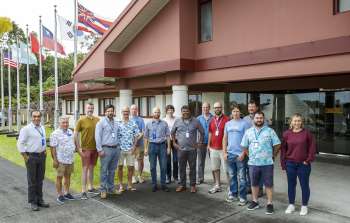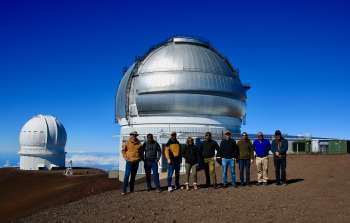sci23046 — Announcement
Gemini hosts GIRMOS team for a tour of Gemini North
September 5, 2023
After much anticipation, the Gemini team was thrilled to host the University of Toronto's GIRMOS team for an extensive tour of our observatory, state-of-the-art labs, and cutting-edge facilities. This engaging week was marked by a series of enlightening presentations, hands-on workshops, and team-building activities.
The primary objective of this visit was to acquaint the GIRMOS team with the intricate logistical aspects of instrument assembly, integration, and testing. However, Gemini seized the opportunity to further enrich this experience by offering a diverse range of presentations covering Software, Engineering & Science Operations, GNAO, and, of course, an in-depth exploration of our facilities and their extensive capabilities.
This immersive week-long tour received invaluable support from the project sponsors, Ruben Diaz and Stephen Goodsell, representing GIRMOS and GNAO, respectively. In particular, the tour was made possible thanks to the unwavering dedication of Gemini's leadership and staff, as well as the gracious accommodation provided by the EAO team, who generously shared their office space with us.
The collaborative synergy between the University of Toronto's GIRMOS team, the GIRMOS consortium, and the Gemini team has not only advanced our shared mission but also fostered a deeper understanding of the intricate workings behind our groundbreaking projects such as GIRMOS. We look forward to continued collaboration and the mutual growth it promises in the realm of astronomical research and innovation and enhancing our observatory’s offerings to the community.
GIRMOS (the Gemini InfraRed Multi-Object Spectrograph) is a powerful next-generation AO (Adaptive Optics) assisted instrument currently being designed and constructed for Gemini North. The project involves a consortium of Canadian universities, including the University of Toronto (as the leading institution), Dalhousie University, Université Laval, Saint Mary's University, University of British Columbia, University of Victoria, and York University, in collaboration with Gemini, NRC-HAA, and KASI.
The primary purpose of GIRMOS is to enable the simultaneous integral-field spectroscopy of four objects within the field-of-regard of the Gemini-North AO (GNAO) system. Alternatively, it can also observe a single object by tiling the four fields that feed light into four separate spectrographs. The instrument's imager operates in a parallel data acquisition mode with minimal vignetting spectroscopic pick-offs when deployed. With its combined multi-object adaptive optics (MOAO) spectroscopy and imaging capabilities, GIRMOS is poised to serve as a versatile tool for a wide set of astrophysical observations.
Suresh Sivanandam from the University of Toronto’s Dunlap Institute leads the GIRMOS project as the Principal Investigator. The instrument has secured funding through an award from the Canadian Foundation for Innovation, supplemented by Canadian provincial sources and in-kind and financial support from Gemini and other partners. GIRMOS is fully aligned with Gemini’s Strategic Scientific Plan and is designated as a high-priority project within the current GPMO portfolio. As the first-light instrument following GNAO, GIRMOS is expected to play a crucial role in achieving Gemini's scientific goals.
In addition to its compelling scientific applications, GIRMOS is expected to capitalize on synergies with other facilities, particularly the James Webb Space Telescope (JWST), to enhance its scientific impact and productivity.
About the Announcement
| Id: |
ID
sci23046
|

